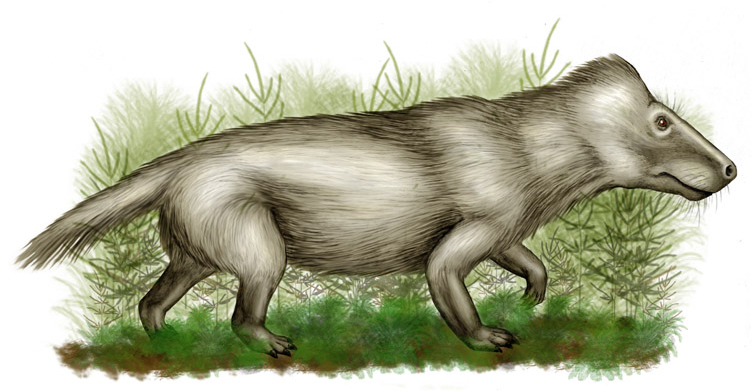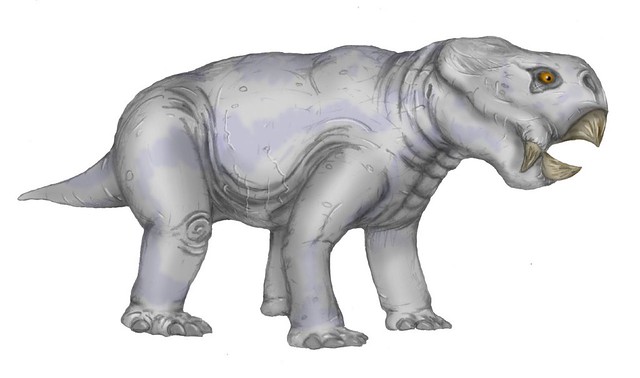[Recent Entries][Archive][Friends][User Info]
January 31st, 2012
| January 31st, 2012 | |
|---|---|
| 06:06 pm [industrialterro] [Link] |
Diademodon Diademodon is an vegetarian extinct genus of therapsid. It was about the size of a small cow. Fossils of the Diademodon tetragonus were found in levels of the Rio Seco de la Quebrada geological formation in Mendoza Province, Argentina.
Tags: Вымершие синапсиды, Триас, терапсиды |
| Time | Event |
| 06:19 pm [industrialterro] [Link] |
Dinodontosaurus Dinodontosaurus (meaning "terrible-toothed lizard") is a genus of dicynodont therapsid. It was one of the largest herbivores of the Triassic (about 8 feet (2.4 m) long and weighing a few hundred pounds) and had a beak corneum. It lived in the Middle Triassic but disappeared in the Upper Triassic. Dinodontosaurus turpior is the most common species of dicynodont that existed in the Middle Triassic, and more common in the fossil layers that age in Rio Grande do Sul, in geopark of paleorrota. They are found mainly in the Paleontological Site Chiniquá in São Pedro do Sul and Candelária , where a group of ten pups were found together, demonstrating that these animals had strategies for coexistence in a group and caring for their offspring. Dinodontosaurus pedroanum was a specie of dicynodonts herbivore that lived in the region of paleorrota, Brazil (8 fossils collected) and Argentina (2 fossils collected). It was described the first time by Tupi Caldas in 1936 and is synonymous Dinodontosaurus oliveirai, Romer 1943. Каннемейериды (Kannemeyeridae seu Kannemeyeriiformes) — семейство крупных дицинодонтов триасовой эпохи. Возможно, потомки листрозавров. Доминирующие растительноядные в течение большей части триаса. Дицинодонт из раннего мела Австралии также, вероятно, относится к этой группе. Группа довольно разнообразна, различные её представители отличаются не только размерами (от овцы до носорога) но и формой и пропорциями черепа и конечностей. Динодонтозавры (Dinodontosaurinae) — единственный род Dinodontosaurus из среднего триаса Южной Америки, 3 вида. Длинноногие короткотелые дицинодонты с длинными верхними клыками, морда короткая.
Ископаемые останки (1, 2, 3, 4):
( Далее ) Tags: Вымершие синапсиды, Триас, терапсиды |
| Time | Event |
| 06:35 pm [industrialterro] [Link] |
Ericiolacerta Эрициолацерта (Ericiolacerta) — мелкий тероцефал раннетриасовой эпохи, принадлежащий к бауриаморфам. Описана Д. Уотсоном в 1931 году. Единственный вид - E. parva из зоны Lystrosaurus раннего триаса Южной Африки. Мелкое животное, общая длина до 20-25 см. Череп грушевидный, удлиненный, уплощенный. Заглазничная дуга неполная. Теменного отверстия нет. Хорошо развито вторичное небо, образованное сошником и небными костями. Квадратные ветви крыловидных костей очень тонкие. Предчелюстная и челюстная кость покрыты множеством отверстий (трактуются как сосудистые отверстия, указывающие на развитие мягких тканей лицевой области). Нижняя челюсть длинная и тонкая, с зачаточным венечным отростком. Симфиз нижней челюсти длинный и скошенный. Зубы мелкие, цилиндрические, клыки не выделяются, первая пара нижнечелюстных зубов направлена косо вперед (“резцы”). Заклыковые зубы со слабо трехраздельными тупыми коронками. Скелет довольно компактный, выражен поясничный отдел позвоночника, три крестцовых позвонка. Хвост короткий. Лопатка длинная и тонкая, верхний конец ее приближен к черепу. Таз низкий, короткий, широкий, с тироидными отверстиями. Кости конечностей длинные, тонкие. Стопа пальцеходящая. В целом по очертаниям скелета животное несколько напоминало ежа. По-видимому, этот высокоразвитый тероцефал был покрыт шерстью, имел развитые вибриссы на морде и внешне походил на млекопитающее. Питалась эрициолацерта насекомыми и другими беспозвоночными, занимая экологическую нишу современных насекомоядных. Остатки этого вида известны и из одновозрастной формации Фремоу в Антарктиде.
Tags: Вымершие синапсиды, Триас, терапсиды |
| Time | Event |
| 06:51 pm [industrialterro] [Link] |
Euchambersia Эучамберсия или эвчамберсия (Euchambersia mirabilis) — хищный тероцефал позднепермской эпохи, близкий к мосхорину, териогнату и аннатерапсиду. Предположительно, имела ядовитые железы, соединявшиеся с бороздами на верхних клыках. Череп высокий, заклыковые зубы отсутствуют, пять резцов и один клык с каждой стороны. Теменного отверстия нет. Отсутствует (вероятно) также полная скуловая и заглазничная дуги. Нёбные отверстия малы. Позади верхних клыков — глубокие вырезки, возможно, вмещавшие ядовитую железу, от этой полости к клыку идет ложбинка. Вырезка соединяется с двумя крупными отверстиями под глазницей (возможный выход сосудов и нервов). На самом клыке есть бороздка и гребень, для стока секрета ядовитой железы, причем борозда идет по передней поверхности клыка. Вторичное небо не развито. Длина черепа 10 см. Скелет и нижняя челюсть неизвестны. Обнаружена в позднепермских отложениях (зона Cistecephalus) Кароо в Южной Африке. Вероятно, питалась относительно некрупной добычей, которую могла проглотить целиком. Тем не менее, не исключено также питание относительно крупными животными типа дицинодонтов. В таком случае, вероятно, эучамберсия наносила добыче укус, а затем ожидала ее гибели, преследуя умирающее животное. Такая тактика, тем не менее, могла быть не очень удачной в условиях конкуренции с другими хищниками (какой-нибудь горгонопс или другой тероцефал мог перехватить ослабевшую добычу).
Tags: Вымершие синапсиды, Триас, терапсиды |
| Time | Event |
| 07:18 pm [industrialterro] [Link] |
Exaeretodon Exaeretodon is a genus of traversodontid cynodont; several species are known, from various formations. E. argentinus, E. frenguelli, and E. vincei are from the Carnian-age (Upper Triassic) Ischigualasto Formation of Argentina. E. major and E. riograndensis are from the Ladinian-age (Middle Triassic) portion of the Santa Maria Formation of Brazil. E. statisticae is from the Carnian-age Lower Maleri Formation of India. This genus was an herbivore up to 1.8 meters long (5.9 ft), with a specialized grinding action when feeding. An analysis of the size of the bones of calves collected in Paleorrota concluded that the mother Exaeretodon had one or two calves, for one pregnancy. Another point of interest is that these cynodonts had deciduous teeth, which is a characteristic of mammals and means that babies could not chew, and required specialized parental care. Only older juveniles had permanent teeth. Exaeretodon is one of the largest traversodontids, but the traversodontid species Ischignathus sudamericanus was reported in 1967 to be even larger. I. sudamericanus was based on a single skull from the Ischigualasto Formation in the same deposit as Exaeretodon argentinus. When he first named the species, Argentine paleontologist José Bonaparte mentioned several features that distinguish it from all other traversodontids. The tooth rows of the upper jaw are more parallel to each other in I. sudamericanus than they are in Exaeretodon, and they are also inset closer to the inside of the mouth. There are also more postcanine teeth oriented toward middle of the subtemporal fenestrae (two holes in the bottom of the skull) and ascending rama of the dentary (projections of the lower jaw that extend up to the skull). The ascending rama are also wider and taller in the I. sudamericanus specimen. The orbit or eye socket is longer than that of Exaeretodon, as are the palatine bones. Despite the differences, a 2007 study concluded that the I. sudamericanus skull represents the same species as E. argentinus. Using allometry, paleontologist Jun Liu found I. sudamericanus to be the largest known example of a growth series in E. argentinus. Thus, Ischignathus is now regarded as a junior synonym of Exaeretodon. As the animal grew, the proportions of bones changed. These differing proportions were initially seen as species-distinguishing characters, but are now regarded as natural ontogenic variation.
Tags: Вымершие синапсиды, Триас, терапсиды |
| Time | Event |
| 07:42 pm [industrialterro] [Link] |
Ischigualastia Ischigualastia was a dicynodont (a group of mammal-like reptiles) that lived during the Carnian age of the Late Triassic Period. From the Ischigualasto Formation of Argentina, it was a member of the family Kannemeyeridae. It is regarded as larger than its later, more famous relative Placerias, which was up to 3.5 meters long (11.5 ft) and weighed one to two tonnes (1.1 to 2.2 short tons). Unlike Placerias, it lacked tusks. It was a large quadrupedal herbivore, most common at the base of the Ischigualasto Formation.
Размеры тела в сравнении с человеком:
Tags: Вымершие синапсиды, Триас, терапсиды |
| Previous Day | 2012/01/31 [Archive] |
Next Day |


























